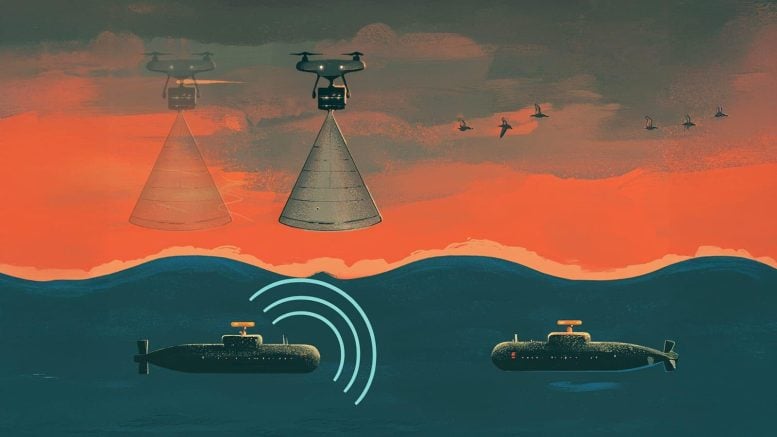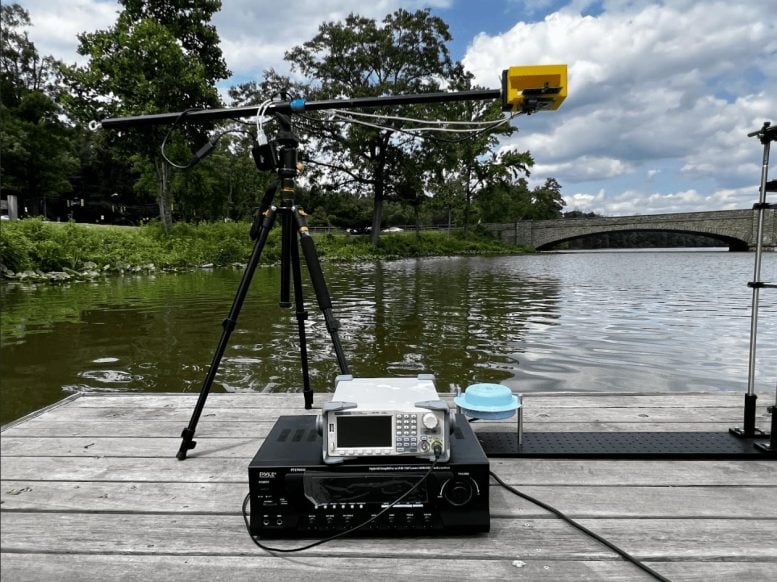
Cross-medium eavesdropping technology challenges long-held assumptions about the security of underwater communications.
Researchers from Princeton and <span class="glossaryLink" aria-describedby="tt" data-cmtooltip="
” data-gt-translate-attributes=”[{"attribute":"data-cmtooltip", "format":"html"}]” tabindex=”0″ role=”link”>MIT
The team created a device that uses radar to eavesdrop on underwater acoustic signals, or sonar, by decoding the tiny vibrations those signals produce on the water’s surface. In principle, the technique could also roughly identify the location of an underwater transmitter, the researchers said.
In a paper presented at ACM MobiCom on November 20, the team described the technology and proposed strategies to defend against the new type of eavesdropping it enables. They successfully demonstrated the system on Lake Carnegie, a small man-made lake in Princeton. While applying this method in the open ocean presents far greater challenges, the researchers believe it could be achieved with substantial engineering advancements.
The researchers said their intention is not only to alert people to the vulnerability of underwater transmissions, but also to detail methods that can be used to prevent interceptions.
“I’m hoping that some of the countermeasure strategies that we propose will be picked up by people who design acoustic transmitters for underwater communication,” said Yasaman Ghasempour, assistant professor of electrical and computer engineering and the study’s principal investigator.
Transmitting messages between underwater and airborne devices was considered technically infeasible until researchers from MIT developed a system to do so in 2018. But the MIT technique relied on cooperation between the air and sea parties — sharing data rates, frequencies, and other key technical details in advance. At the time, it wasn’t clear whether this technique could be used to intercept private messages from non-cooperative underwater transmitters.

Collaborating with the MIT group, Ghasempour and her Princeton team explored the security implications of the technology and developed a way to decipher the same kinds of messages without knowing any of those technical details.
The researchers said the ability to intercept underwater communications from the air poses a wide array of security risks. They said an adversary could use the technology to intercept sensitive information transmitted by climate monitoring sensors, oil and gas rigs, and even submarines.
“This work shows that sensitive information can be leaked in ways that previously haven’t been considered,” said Poorya Mollahosseini, a graduate student at Princeton and the paper’s co-lead author with Sayed Saad Afzal, a graduate student at MIT.
How are underwater communications protected?
The security of underwater communications relies heavily on the inability of sound traveling underwater to penetrate the surface, the researchers said. Signals that carry information are transmitted underwater as sound waves. Because water and air have very different densities, the water’s surface acts as a barrier for sound. When underwater sound waves hit the surface, they mostly just bounce off.
In 2018, the MIT group realized that the impact of the sound waves on the water’s surface leaves a sort of fingerprint of tiny vibrations that correspond to the underwater signal. The team used a radar mounted on a drone to read the surface vibrations and deployed algorithms to detect the pattern, decode the signal, and extract the message.
“Underwater-to-air communications is one of the most difficult long-standing problems in our field,” said Fadel Adib, associate professor of media arts and sciences at MIT and co-author on the new paper. “It was exciting – and surprising – to see our method succeed in decoding underwater messages from the tiny vibrations they caused on the surface.”
But for the technique to work, the MIT team’s system required knowledge of certain physical parameters, such as the transmission’s frequency and modulation type, in advance.
Building on this development, the team at Princeton used a similar method to detect the surface vibrations, but developed new algorithms that capitalize on the differences between radar and sonar to uncover those physical parameters. That allowed the researchers to decode the message without cooperation from the underwater transmitter.
Using an inexpensive commercial drone and radar, the researchers tested their method in a swimming pool. The researchers deployed a speaker under the water and, as swimmers provided interference, flew a drone over the surface. The drone repeatedly sent brief radar chirps toward the water. When the radar signals bounced off the water’s surface, they revealed the pattern of vibrations from the sound waves for the system to detect and decode.
The researchers also used a boom-mounted radar for tests in a real-world environment at Carnegie Lake in Princeton. They found that the system could figure out the unknown parameters and decode messages from the speaker, even with interference from wind and waves. In fact, it could determine the modulation type, one of the most important parameters, with 97.58% <span class="glossaryLink" aria-describedby="tt" data-cmtooltip="
” data-gt-translate-attributes=”[{"attribute":"data-cmtooltip", "format":"html"}]” tabindex=”0″ role=”link”>accuracy.
“We wanted to show that this could be done with off-the-shelf, basic equipment,” Ghasempour said. “Imagine what someone could do with a more sophisticated radar.”
They found that the design parameters of an underwater communication link greatly impact its susceptibility to such attacks. Some types of modulation, for example, are easier to figure out than others. The paper provides recommendations on ways to design transmitters that are more resistant to eavesdropping. Ghasempour said that she hopes to follow up to provide more suggestions for ways to protect against these kinds of attacks.
The article, SURF: Eavesdropping on Underwater Communications from the Air, was presented Nov. 20 at ACM MobiCom in Washington, D.C. Support for the research was provided in part by the National Science Foundation, the Office of Naval Research, and <span class="glossaryLink" aria-describedby="tt" data-cmtooltip="
” data-gt-translate-attributes=”[{"attribute":"data-cmtooltip", "format":"html"}]” tabindex=”0″ role=”link”>Princeton University’s Project X Innovation Fund.
